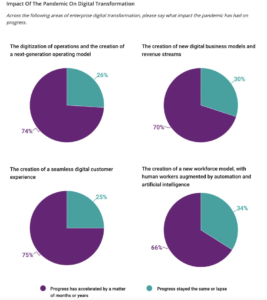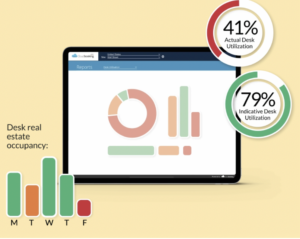
The tech we use in the workplace has advanced by leaps and bounds, enabling organisations to digitalise processes that previously had to be performed manually. For example, software can now automatically track and report data in real-time — a task that used to be tedious and dependent on manual data entry with spreadsheets.
The digital transformation of the workplace has also enabled workforces to transition to new ways of working. This transformation came into focus over the past two years as the pandemic forced entire companies to shift to work-from-home arrangements overnight. For instance, a KPMG report shows that the majority of US CEOs saw their digital transformation initiatives accelerate in growth by months and even years due to the COVID-19 crisis.

With benefits that make work better for both employees and organisational leaders alike, new workplace technologies are creating new efficiencies, new business models and new opportunities for staying competitive.
What is workplace technology?
Workplace technology is a catch-all term that refers to any hardware or software solutions used in the workplace. But in the modern era, workplace technology might as well be synonymous with digital and cloud-based technologies.
These tools and solutions, in turn, are powering the advent of the digital workplace (also known as a smart office) — a high-tech workplace where multiple digital and cloud-based systems combine to create a seamless online and offline ecosystem for workers.
Related Reading: What Is a Smart Office? Key Benefits and How It Works
Over the past 10 years, workplace technologies such as analytics and the Internet of Things (IoT) have allowed organisations to:
- Open up information silos and improve the transferability of internal data and communications
- Improve operational efficiency at scale and drive down costs
- Enhance collaboration and communication among dispersed teams and maintain high levels of productivity and innovation
- Keep up with cultural changes in the workplace, such as the push for flexible working and diversity and inclusion (D&I)
- Track and report on more precise and accurate data to make decision-making more effective
- Connect teams and align your entire organisation with your values, mission and goals.
3 workplace technologies to embed in your digital workplace
1. Workforce data analytics
Workforce analytics refers to a broad set of advanced data analysis tools, metrics and key performance indicators (KPIs) that enable the tracking and measurement of everything from employee performance to Net Promoter Score (NPS). The idea is simple: workforce analytics platforms allow leaders and employees themselves to make informed decisions based on actual data instead of guesswork.
Although data analytics solutions have been around for years, there’s plenty of room for growth. Case in point: NewVantage Partners’ 2019 Big Data and AI Executive Survey found that 72% of C-level business and tech executives from big firms had yet to build a data culture, and 69% did not have a data-driven organisation.
Cloudbooking Tip: Workforce analytics capabilities are now available from application vendors as a built-in feature. Depending on your software product, you can use analytics to analyse recruitment history, seasonal staffing demand, diversity and inclusion, as well as absenteeism and turnover, among other things. But you can also use data analytics to monitor office activities, such as foot traffic, floor plan capacity and meeting room usage.
At Cloudbooking, our workplace management platform lets you use real-time analytics data to build personalised workspaces and optimise office capacity based on employee activity, usage and movement.
2. Desk and meeting room booking
Workspace hoteling systems such as desk booking or meeting room booking software can make a world of difference to your organisation’s efforts to shift to hybrid working and other new ways of working, such as agile and activity-based working.
Related Reading: The Manager’s Guide to Activity-Based Working (ABW) in the Hybrid Era
Office hoteling, also known as desk hoteling, desk booking, and workspace hoteling, is an agile and flexible method of office management where employees share desks, meeting rooms, conference rooms, and workstations on a dynamic schedule. This allows workers on a hybrid schedule to reserve desks on the days they have to come to the office.
The concept of allowing employees to reserve workspaces seems revolutionary, but it’s hardly new. In 1993, Ernst & Young downsized their Orange County offices from four spaces to just one and used office hoteling to help workers schedule their “office time.” Though the move drew criticism, it allowed EY to reduce its office space costs by 40%.
Related Reading: 7 Answers to FAQs About Office Hoteling
3. AI-powered virtual assistants
For many years, virtual assistants (VA) have been exclusive to C-level executives and upper workforce management. But the increasing accessibility of software and programs powered by artificial intelligence has also made chatbots and VA software more accessible to all workforces.
Already we’re seeing AI-powered VAs help employees with all kinds of administrative tasks, such as:
- Scheduling appointments
- Answering emails
- Sending team updates on tasks and projects.
VAs, however, aren’t going to replace humans anytime soon. Rather, they handle many of the routine and repetitive tasks, freeing teams like your HR personnel and accountants to focus on more strategic work. The possibilities for VAs in the workplace are limitless; Gartner predicts that by 2025, 50% of knowledge workers will use a VA every day — up from 2% in 2019.
Related Reading: 7 Things You Need to Build a More Connected Workspace
Leverage workplace technology to prepare for the future of work
Whether your goal is to modernise your office or switch to a permanent remote or hybrid working arrangement, now is the time to invest in key workplace technologies. Take the time to assess what your teams need to determine which tools, software and solutions make the most sense in terms of efficiencies and ROI.
Cloudbooking’s workspace management system can help make your offices “smarter.” Our cloud-based solution enables desk and meeting room booking in your workplace — making it an excellent choice for hybrid working teams. You can also use our built-in analytics to analyse how your people and visitors interact with workspaces. Get in touch with our team to schedule an obligation-free demo.



